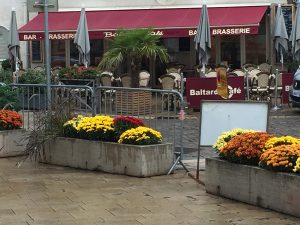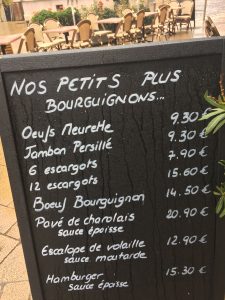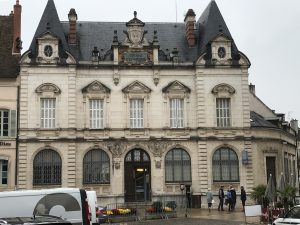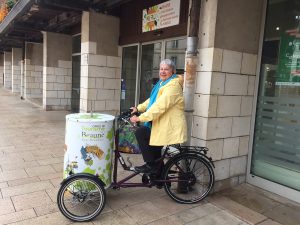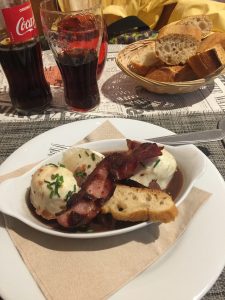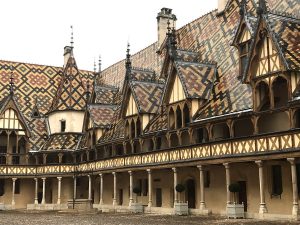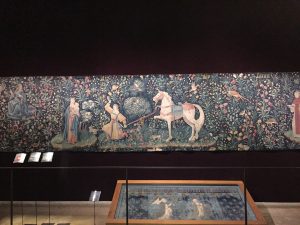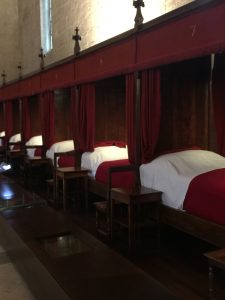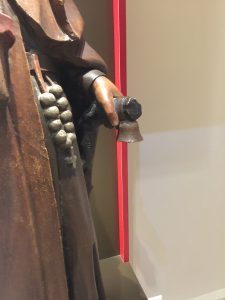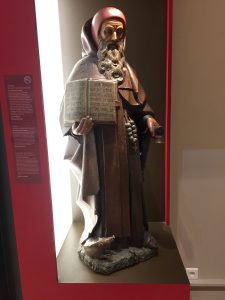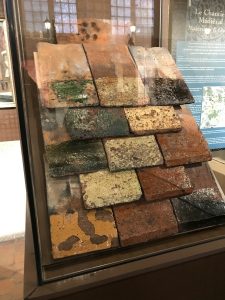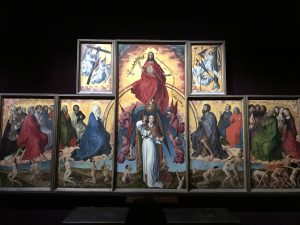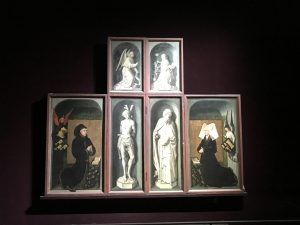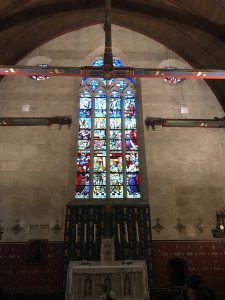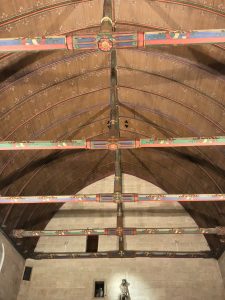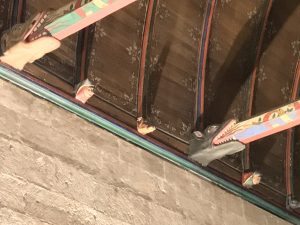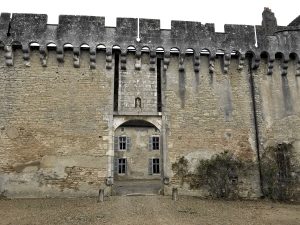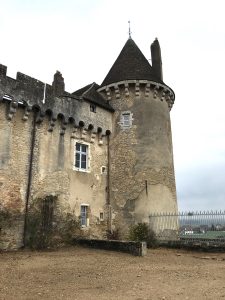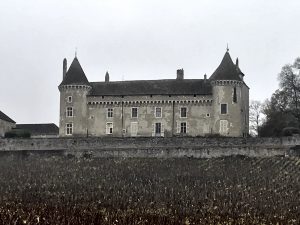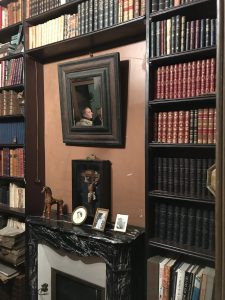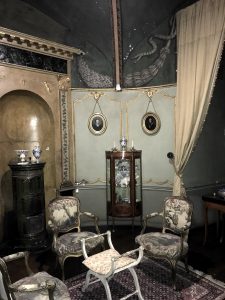Burgundy and Provence
Friday
Beaune and Château de Rully
This was a fun and crazy day for each of us. First of all, though the ship was docked in Macon, on the Saône river, we weren’t going to do anything there. Instead, we were going to Beaune, some miles away and spend some time in the Burgundy Vineyards there rather than those in the Maconnais region, where the ship was docked. Of course, there were other attractions in Beaune itself, so the coach trip wasn’t necessarily a bad thing. We left the ship in Macon with different groups at different times, we crossed paths at mid-day, we enjoyed a short break in a pastry shop together in the middle of the day, and we each had unique fun experiences. What could be better?
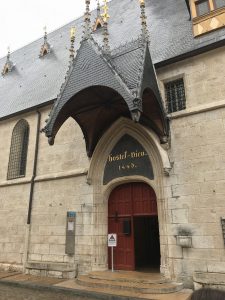 My group of about 20 people left early and took the autoroute directly to Beaune. The main reason for visiting this city was to tour the restored Hôtel Dieu there, in the heart of the old centre of the town. We had a few minutes to wander through this part of town before it opened for the first tourist group of the day, and I have to admit I checked out a few coffee shops with a little bit of longing in my heart. A lot of those pastries in the windows were very tempting. But, I resisted and went past each one without stopping to rejoin my group and enter the hospital.
My group of about 20 people left early and took the autoroute directly to Beaune. The main reason for visiting this city was to tour the restored Hôtel Dieu there, in the heart of the old centre of the town. We had a few minutes to wander through this part of town before it opened for the first tourist group of the day, and I have to admit I checked out a few coffee shops with a little bit of longing in my heart. A lot of those pastries in the windows were very tempting. But, I resisted and went past each one without stopping to rejoin my group and enter the hospital.
 When we were in Arles, we had seen only the courtyard of the hospital there, largely to look at van Gogh’s painting of it displayed in front of the subject itself. This was a different experience altogether. Founded in 1443, the Hôtel Dieu in Beaune had been in use as a hospital continuously until 1971. What!? Yes, for well over 500 years. When the working components of the hospital were moved to a new facility, the original buildings were restored to their original state, either with furnishings from the 15th century or with copies, as a Museum. The weather wasn’t good, drizzling rain all day, but even on a cloudy day the buildings as seen from the courtyard were stunning. The tour was really enlightening, and even a few exhibits that had “stuffed people” didn’t bother me too much. Don’t miss this place if you’re in the area, and don’t forget to check out the photos at the bottom of this page.
When we were in Arles, we had seen only the courtyard of the hospital there, largely to look at van Gogh’s painting of it displayed in front of the subject itself. This was a different experience altogether. Founded in 1443, the Hôtel Dieu in Beaune had been in use as a hospital continuously until 1971. What!? Yes, for well over 500 years. When the working components of the hospital were moved to a new facility, the original buildings were restored to their original state, either with furnishings from the 15th century or with copies, as a Museum. The weather wasn’t good, drizzling rain all day, but even on a cloudy day the buildings as seen from the courtyard were stunning. The tour was really enlightening, and even a few exhibits that had “stuffed people” didn’t bother me too much. Don’t miss this place if you’re in the area, and don’t forget to check out the photos at the bottom of this page.
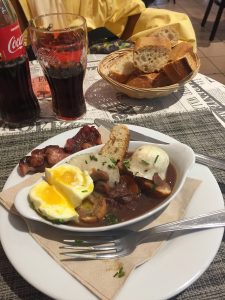 The tour took us almost up to lunch time, and we had more free time to explore the town before our group was to go to the Château de Rully to taste some of the local product and stay for lunch with the Count. When I left the hospital, through the gift shop of course, I saw that Judy’s group had just arrived. Her group had left the ship a little later than we had, and they had taken the local roads through vineyards and farmland rather than sipping along the autoroute like we had done. She had some free time as well and we did go in a coffee shop for pastry and a cappuccino and a little photo swap. Although they had stopped at a vineyard along the way for a quick photo op-in the rain. She also showed me photos of fields of Canola, something neither one of us had heard of before. Who knew canola was actually a plant? We should have realized it, I suppose. After that break we did shop a little, and Judy bought a little tapestry bag in a shop run by a really nice couple who didn’t laugh too much at my bad French. I returned to my group while Judy started looking for a place to have lunch before her group toured the Hôtel Dieu. She had a local specialty-Oeufs Meurette-which seems like a dish I’d like to try as well. Poached eggs in a wine sauce, topped with a slice of bacon. How could that be anything but delicious?
The tour took us almost up to lunch time, and we had more free time to explore the town before our group was to go to the Château de Rully to taste some of the local product and stay for lunch with the Count. When I left the hospital, through the gift shop of course, I saw that Judy’s group had just arrived. Her group had left the ship a little later than we had, and they had taken the local roads through vineyards and farmland rather than sipping along the autoroute like we had done. She had some free time as well and we did go in a coffee shop for pastry and a cappuccino and a little photo swap. Although they had stopped at a vineyard along the way for a quick photo op-in the rain. She also showed me photos of fields of Canola, something neither one of us had heard of before. Who knew canola was actually a plant? We should have realized it, I suppose. After that break we did shop a little, and Judy bought a little tapestry bag in a shop run by a really nice couple who didn’t laugh too much at my bad French. I returned to my group while Judy started looking for a place to have lunch before her group toured the Hôtel Dieu. She had a local specialty-Oeufs Meurette-which seems like a dish I’d like to try as well. Poached eggs in a wine sauce, topped with a slice of bacon. How could that be anything but delicious?
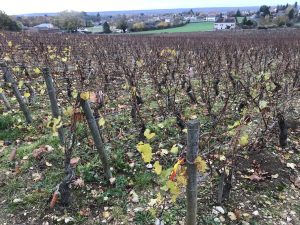 When all the members of my group finally managed to get on the tour bus, we left Beaune for a drive through the nearby villages and vineyards, continuing south to the village of Rully. Along the way we passed many places/villages/clos/terroirs/climats whose names I recognized from wine labels that I couldn’t begin to list them here. After all, we would ride through three of the named Burgundy regions by the time we reached the ship; that’s a lot of grapes! I just about had an excitement OD reading the names as we motored on through the area. And my mouth was watering-not because it was lunch time, either. If the weather had been better and Judy and I were in a car, we’d have stopped again and again, just so I could get out of the car and pet some of the vines whose fruits I had enjoyed so much at home.
When all the members of my group finally managed to get on the tour bus, we left Beaune for a drive through the nearby villages and vineyards, continuing south to the village of Rully. Along the way we passed many places/villages/clos/terroirs/climats whose names I recognized from wine labels that I couldn’t begin to list them here. After all, we would ride through three of the named Burgundy regions by the time we reached the ship; that’s a lot of grapes! I just about had an excitement OD reading the names as we motored on through the area. And my mouth was watering-not because it was lunch time, either. If the weather had been better and Judy and I were in a car, we’d have stopped again and again, just so I could get out of the car and pet some of the vines whose fruits I had enjoyed so much at home.
The Château
But—enough reminiscing. We reached the château, stopped for a quick photo op in the drizzle, and headed on into the castle. Sometimes you dream about a place, or you just get all excited by photos or even the name, and when you finally get there the reality of it exceeds all your expectations. On the other hand, sometimes the reality falls short. This visit was probably like most such trips to dreamed of places–there was some good and some not-so-good in the reality.
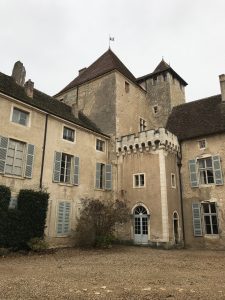 The best part was just being there, walking through the buildings, ogling the artifacts, meeting the owners, and seeing the vineyards. Just walking into the main courtyard, through a gate in the crenalated wall, was fun. The oldest part of the chateau, the square part in this photo, was built in the 12th century; it’s now the kitchen, where their web site says they conduct private tastings for small groups. Check out the photos below. You’ll see rooms furnished in all sorts of styles, including some 18th-century ornamentation. I really enjoyed noticing all the contrasts as we went from room to room.
The best part was just being there, walking through the buildings, ogling the artifacts, meeting the owners, and seeing the vineyards. Just walking into the main courtyard, through a gate in the crenalated wall, was fun. The oldest part of the chateau, the square part in this photo, was built in the 12th century; it’s now the kitchen, where their web site says they conduct private tastings for small groups. Check out the photos below. You’ll see rooms furnished in all sorts of styles, including some 18th-century ornamentation. I really enjoyed noticing all the contrasts as we went from room to room.
 The current Count, whose family has owned the château for centuries, was our host and guide, and his easy manner made the whole tour more interesting. One of the items ex showed us really impressed me not only for its inherent quality but also for its history. The chest was built by his great-grandfather (maybe more generations back than that?) and exhibited at the Paris Exposition Universelle in 1889. There’s a framed certificate granting a gold medal from the Exposition to Monsieur le Comte de Montessua [AKA le Comte de Rully, according to Wikipedia] for the chest that is still in the home. That might not sound like much to most people, but I had one of those funny feelings I get when some obscure music history fact is relevant to something entirely different. The 1889 Exposition is widely recognized as a pivotal point in the music of Claude Debussy, because that’s where he heard Javanese gamelan music. That just warmed the cockles of the academic side of my heart a bit.
The current Count, whose family has owned the château for centuries, was our host and guide, and his easy manner made the whole tour more interesting. One of the items ex showed us really impressed me not only for its inherent quality but also for its history. The chest was built by his great-grandfather (maybe more generations back than that?) and exhibited at the Paris Exposition Universelle in 1889. There’s a framed certificate granting a gold medal from the Exposition to Monsieur le Comte de Montessua [AKA le Comte de Rully, according to Wikipedia] for the chest that is still in the home. That might not sound like much to most people, but I had one of those funny feelings I get when some obscure music history fact is relevant to something entirely different. The 1889 Exposition is widely recognized as a pivotal point in the music of Claude Debussy, because that’s where he heard Javanese gamelan music. That just warmed the cockles of the academic side of my heart a bit.
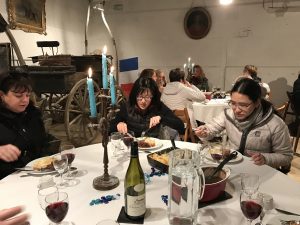 The history of the chateau was evident in other ways, of course. Just looking at the structure from a distance was enlightening, and walked through the courtyard showed interesting little points at almost every turn. I think one of the most fun points was lunch, which was held in the former stable. The meal had been prepared by our host and his family, and we enjoyed the fruits of the vineyard with the really excellent food.
The history of the chateau was evident in other ways, of course. Just looking at the structure from a distance was enlightening, and walked through the courtyard showed interesting little points at almost every turn. I think one of the most fun points was lunch, which was held in the former stable. The meal had been prepared by our host and his family, and we enjoyed the fruits of the vineyard with the really excellent food.
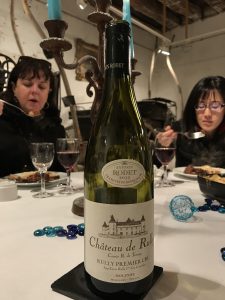 If I’m truly honest, I have to say that the white wine itself was not the best reason for enjoying the visit. That was a disappointment, because I had truly enjoyed a bottle of Rully (white Burgundy) years before this trip. It had that wonderful flavor I associate with some Russian River Valley chardonnays, especially Sonoma Cutrer. Officially, this house is not one of the Premier Cru vintages of the region for white wines, so I guess that explains some of the difference. And no doubt the whole aging process has a lot to do with it as well. On the other hand, the red wine was truly delicious, and as an accompaniment to a meal served by a Count in the stable of a château dating back centuries, it was incomparable!
If I’m truly honest, I have to say that the white wine itself was not the best reason for enjoying the visit. That was a disappointment, because I had truly enjoyed a bottle of Rully (white Burgundy) years before this trip. It had that wonderful flavor I associate with some Russian River Valley chardonnays, especially Sonoma Cutrer. Officially, this house is not one of the Premier Cru vintages of the region for white wines, so I guess that explains some of the difference. And no doubt the whole aging process has a lot to do with it as well. On the other hand, the red wine was truly delicious, and as an accompaniment to a meal served by a Count in the stable of a château dating back centuries, it was incomparable!
Where did they go? What did they see?
Arles and Les Baux de Provence

